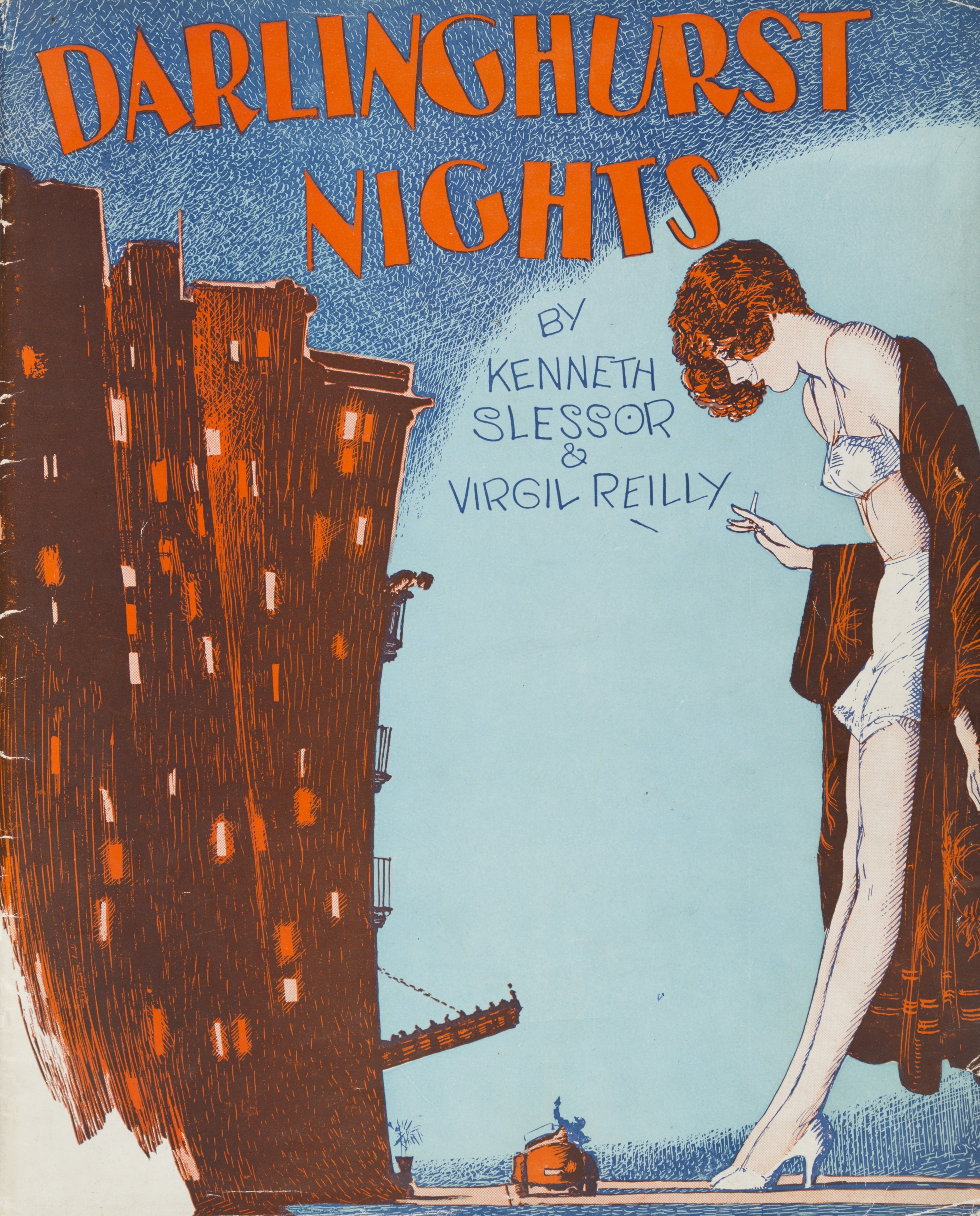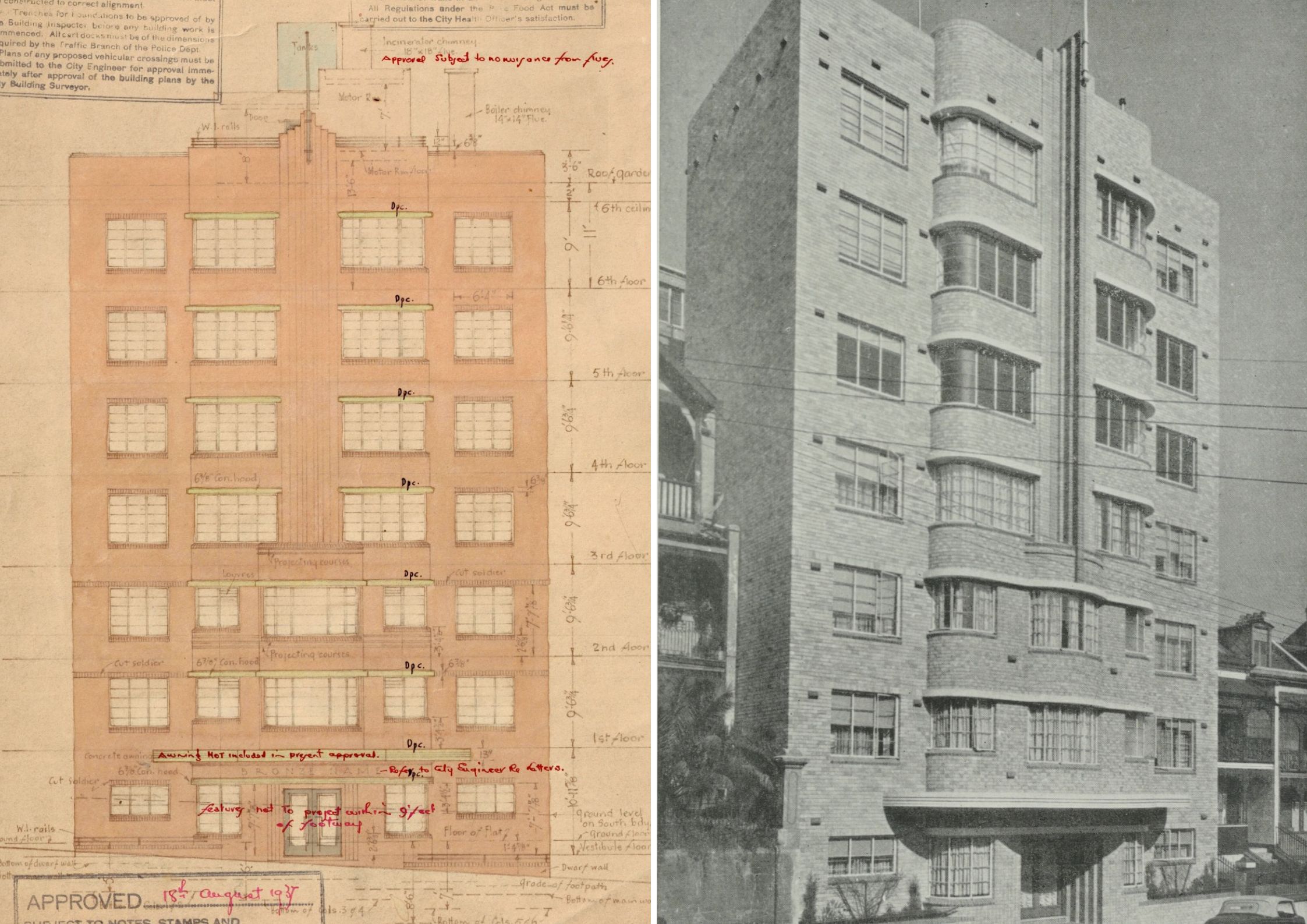…I stood gaping at a land of towers and belfries, an eerie kingdom of lead pipes and gilded weather-cocks. I smelt things - garlic, spaghetti, chops, meat-pies and sausages. I saw things - buildings that climbed like mad, stone mountains into the clouds. I heard things - electric pianos and ukuleles. I felt things - mosquitos, beetles, moths and fleas. I tasted things - beer, dust, lobsters and face-powder.
So Darlinghurst enveloped me, and took me captive.
Kenneth Slessor, 19231

Cover of 'Darlinghurst Nights' by Kenneth Slessor and Virgil Reilly, 1932
Published by Frank C Johnson, State Library of NSW, [QA827/S632/1A]
When he was describing ‘Darlinghurst’ the Australian poet, Kenneth Slessor, was thinking of Kings Cross, specifically the area around Kings Cross Road. However, his evocative imagery can also be applied to the frenzy of flat development occurring in the suburbs of Potts Point and Darlinghurst from the 1910s to the 1930s.
At around this time, Liverpool Street was rising and transforming. The Assessment Books of 1907 describe the street as containing 176 houses, 37 shops, five hotels, two stables, one hospital and a wool and coal yard. And the 1911 Assessment Books record a similar number for each.2
However, the 1914 Assessment Books signalled a change in the type of developments seen on Liverpool Street, as it recorded the first ‘shop and flats’ in the form of John C Hallam’s premises on the corner of Liverpool and College streets.
The three-storey building, formerly known as ‘Booth’s Hydropathic Baths’ and constructed in 1880, was converted into a flat building and recorded as containing 17 rooms. The word ‘flats’ can be misleading to today’s readers, as these establishments essentially functioned as boarding houses with common kitchens and bathrooms. The building was demolished in 1917 as part of the widening of Oxford Street.3

The first 'flats' on Liverpool Street, Darlinghurst, 1917
The former Hydropathic Baths and boarding house on the corner of Liverpool and College streets, Demolition Books, City of Sydney Archives, A-01000423
By the next Assessment Books series dated 1921, seven flat buildings and/or boarding houses are recorded. These included the Government Savings Bank of New South Wales building, which was constructed in 1918 and contained a bank chamber and one flat on the ground floor, and six flats on the first and second floors, each containing a kitchen, bathroom and living rooms. The bedrooms featured ‘Oscillating Portal Wall Beds’ patented by the American Wall Bed Company, which were a space-saving device in which beds could be folded into a recessed wall space. The building still stands at 140-142 Liverpool Street, Darlinghurst.4

The 'Oscillating Portal Wall bed' which revolves into a recessed space and turns into a writing desk, 1916
Detail from an American Wall Bed Company trade catalogue, 5, Caroline Simpson Library and Research Collection, Museums of History NSW, [TC 749.3 AME]
The other ‘flats’ on the street in 1921 were ‘Fairmont Flats’, formerly Oak Cottage which was constructed in the 1850s, ‘Gloucester and Cotswald Flats’ at numbers 337-339 Liverpool Street, formerly ‘Sea View Terrace’ (constructed in at least 1855), and ‘Lynton’ which contained nine flats.5
The construction of flat buildings formed part of a broader movement in Sydney which encompassed developments in public transport, roads and construction. In 1908-09 the New South Wales Government conducted a Royal Commission into the Improvement of the City of Sydney and its Suburbs. Recommendations included the widening of Oxford and William streets to 100 feet to ‘create boulevards’ on the eastern approaches to the city, as well as new forms of mixed-use and higher density buildings. By 1917, The Sun newspaper reported £400,000 had been invested in flat building.6
There were also significant societal shifts at this time, which changed the way people lived in and perceived the city. Although some Sydneysiders pursued the dream of fresh air and space in the suburbs, others were attracted to the ’lure’ of the big city on the harbour, in particular the inner suburbs of Potts Point and Darlinghurst with its apartments and high ridgelines.
In 1917 the Real Property Annual declared the rise in ’tenement living’ was partially attributed to long work commutes and partly to the ‘servant problem’ – the ‘scarcity of domestics left housewives without assistance in their suburban homes’. Another reason, the writer notes, was that the departure of men for the war had forced some women and their children to abandon their suburban home for a more manageable, furnished flat.7
These statements were, of course, a gendered oversimplification of what was, especially after the beginning of World War I, a period of great social, economic and urban change. As author, Delia Falconer, eloquently puts it:
From the 1920s especially, a boom in apartment living on or near the harbour afforded greater freedoms to women. These flats, some in new buildings and others bedsits carved out of once-grand homes, offered privacy, access to work and the intellectual life of the city, an escape from unpaid domestic labour and freedom from the watchful eyes of family and suburban neighbours.8

Mont Clair, 347 Liverpool Street, Darlinghurst, 1938
Detail from elevation plan by architects E B Wilshire and Hodges (left), City of Sydney Archives and photograph (right) from Building 62, no. 372, 24 August 1938, 24, National Library of Australia, [A-00574472 and N 690.6 BUI]
Within a few years, Liverpool Street’s ‘flats’ went beyond the stately mansions-turned-bedsits, and featured Art Deco style, higher density flat buildings on a much more ambitious scale.
In 1937 it was reported a seven-storey block of residential flats was being constructed at 347 Liverpool Street, Darlinghurst. The reinforced concrete, face brick building was to be ‘soundproof and fire-resistant’ and contain 42 ‘self-contained, modern, electrically equipped’ flats, some with harbour views. The building, ‘Mont Clair’, was designed by architects, Esmond B Wilshire and Hodges and constructed by S D C Kennedy and Bird Ltd.9
Of particular note was, and still is, its curved concrete cantilever awning over the main entrance doors, and its ‘mottled biscuit’ toned brickwork. Decoration and glass magazine praised its curved windows, projected centre bays and use of ‘glass bricks’ which ran vertically the whole height of the building. It’s design, according to the magazine, made it ‘ideal for the bachelor, the business girl and the small business family’.
Meanwhile another key industry magazine, Building, called it an ‘outstanding’ example of the ‘modern flat’ building, with the façade featuring a ‘clear cut’, ’efficient and attractive’ design. The building also had its own ‘inter-house communication’ with the manager’s office and telephone, controlled by a general switchboard operaor.10
Other buildings rose on the street, including ‘Turtan’ designed by William C Brown on the corner of Hardie Street in 1935, neighbouring 387-389 Liverpool Street (1938-39) and ‘Ballina flats’ on the corner of Liverpool and Darley streets (1936-39), formerly the site of Oak Cottage and later ‘Fairmont Flats’.11

'Ballina' (left) and 'Turtan' flats (right), 1939 and 1935
Detail from elevation plans for 359 and 385 Liverpool Street, Darlinghurst, City of Sydney Archives, [A-00575749 and A-00570137]
Read the next story: The Chronicler of Barcom Glen.
Kenneth Slessor, ‘The Prisoner of Darlinghurst: A Warning to Those Who Have Managed to Keep Their Freedom’, The Home 4, no. 1, 1 March 1923, 32, https://nla.gov.au/nla.obj-379197699. ↩︎
Assessment Book - Bligh Ward, 1907 (01/01/1907 - 31/12/1907), [A-01089450]. City of Sydney Archives, https://archives.cityofsydney.nsw.gov.au/nodes/view/1842342 and Assessment Book - Macquarie Ward, 1907 (01/01/1907 - 31/12/1907), [A-01089111]. City of Sydney Archives, https://archives.cityofsydney.nsw.gov.au/nodes/view/1842003. ↩︎
Assessment Book - Macquarie Ward, 1914 (01/01/1914 - 31/12/1914), [A-01089108]. City of Sydney Archives, https://archives.cityofsydney.nsw.gov.au/nodes/view/1842000. ↩︎
Assessment Book - Macquarie Ward, 1921 (01/01/1921 - 31/12/1921), [A-01089106]. City of Sydney Archives, https://archives.cityofsydney.nsw.gov.au/nodes/view/1841998, Liverpool St (140-142) (Government Savings Bank of NSW) (01/01/1917 - 31/12/1917), [A-00570700]. City of Sydney Archives, https://archives.cityofsydney.nsw.gov.au/nodes/view/1442656. ↩︎
Assessment Book - Bligh Ward, 1921 (01/01/1921 - 31/12/1921), [A-01089446]. City of Sydney Archives, https://archives.cityofsydney.nsw.gov.au/nodes/view/1842338. ↩︎
Philip Thalis and Peter John Cantrill, ‘Built environment’, Dictionary of Sydney, 2008, http://dictionaryofsydney.org/entry/built_environment and ‘Sydney’s Flats’, The Sun, 14 July 1917, 4, http://nla.gov.au/nla.news-article221405011. ↩︎
‘Flat Life in Sydney: Rapid Expansion in Few Years, Modern Buildings Pay’, The Real Property Annual, no. 6 (August 1917): 34, https://nla.gov.au/nla.obj-3102312230. ↩︎
Delia Falconer, ‘A City of One’s Own: Women’s Sydney’, Dictionary of Sydney, 2014, http://dictionaryofsydney.org/entry/a_city_of_ones_own_womens_sydney. ↩︎
‘Flats at Darlinghurst’, Sydney Morning Herald, 16 November 1937, 5, http://nla.gov.au/nla.news-article17406461. ↩︎
‘Mont Clair, Darlinghurst, Decoration and glass 4, no. 4, 1 August 1938, 10-14, http://nla.gov.au/nla.obj-372874883, ‘The Modern Flat’, Building 62, no. 372, 24 August 1938, http://nla.gov.au/nla.obj-301897356 and Liverpool St (347) (01/01/1937 - 31/12/1937), [A-00574472], City of Sydney Archives, https://archives.cityofsydney.nsw.gov.au/nodes/view/1455206. ↩︎
Liverpool Street (385) corner Hardie Street residential building called Turtan (01/01/1935 - 31/12/1935), [A-00570137]. City of Sydney Archives, https://archives.cityofsydney.nsw.gov.au/nodes/view/1437985, Plan - 387-389 Liverpool Street Darlinghurst, 1938 (01/01/1938 - 31/12/1938), [A-00552802], City of Sydney Archives, https://archives.cityofsydney.nsw.gov.au/nodes/view/1426036 and Liverpool St (359) & Darley St (5). (01/01/1939 - 31/12/1939), [A-00575749], City of Sydney Archives, https://archives.cityofsydney.nsw.gov.au/nodes/view/1441049. ↩︎

